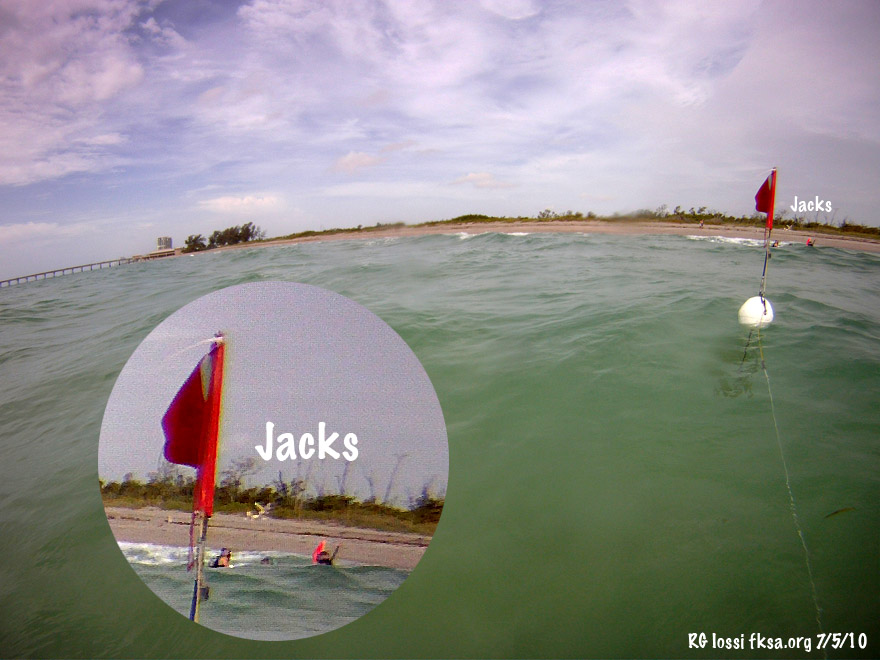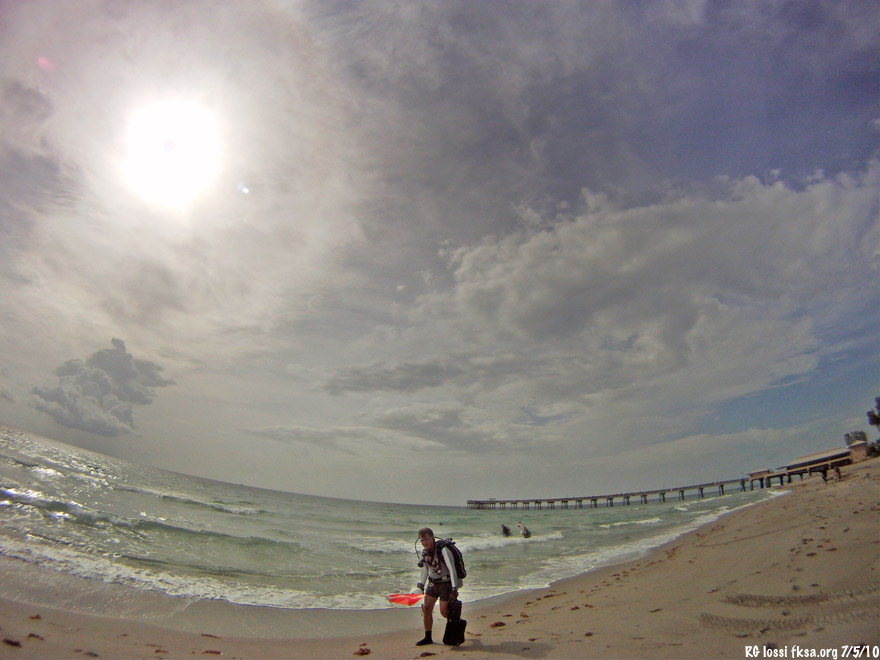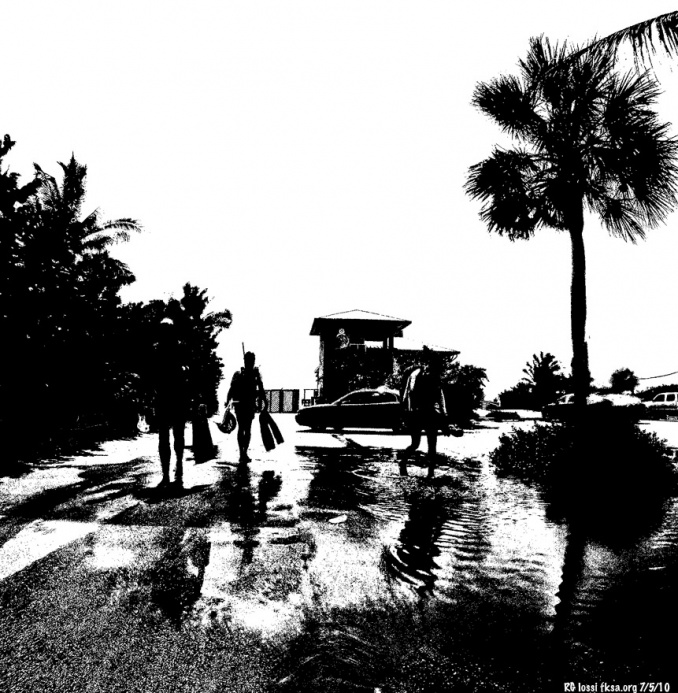
 |
|
#1
|
||||
|
||||
 Back in the 1960's the Erosion Prevention District constructed two submerged groin structures with the intent of inhibiting long shore transport and loss of sediment from beaches. The southern aerojack structure was constructed 2 miles south of Port Everglades Inlet and 1/3 mile north of the Dania Fishing Pier. It extends from about 335 ft. off the beach eastward to the second reef terrace and a western facing ledge. It crossed a sand channel with the intent of inhibiting sand flow which it apparently failed to do in substantial measure. The concept may have originally been developed for using erojacks to form jetties and breakwaters.  A Maptech nautical chart of the area showing the erojacks as a "submerged groin" crossing a depressional area between reefs. The way I heard about this dive was through an excellent Internet "Meetup" site managed by Steve, Brian and Dave of Gold Coast Scuba in Ft. Lauderdale By-The-Sea, FL. It is a real active group with tons of dives going most weeks. You can usually find something to fit into your schedule. The more folks that participate, likely the more diverse dives might be in the offing. Have a few ideas myself for suggested dives. Sure are a lot of spots out there to hit. More at: http://www.meetup.com/goldcoastscuba/ They used to have iron forms over in Port Everglades for casting these jacks. There are some circular erojack reefs off Sunrise Blvd. in about 60 ft. of water as well. A sand tracer study was done in the 1970's which indicated most sand would readily pass over time through the structure. Water depths along the structure are typically on the order of 15 ft.. The jacks attract a considerable quantity of marine life. Even though the concrete comprising the jacks has had superlative longevity with next to no spawling or delamination cracking there has been limited coral growth. There are some hard corals growing on the jacks, soft tissued zooanthids, sea fans, bryozoans and crustose algae.  Folks may park in the municipal lot south of the pier. It was $1.50 per hour for parking. It is a good 1/3 mile walk north from the pier to the erojack reef. You can see some jacks standing on the beach about 30 ft. to the south of the structure. The jacks start about 335 ft. off the beach and extend about 1475 ft. east. The structure stops at the inner ledge of the second reef terrace which created a lateral boundary for sand migration.  Looking south to the pier By law we're supposed to stay at least 100 yards away from the fishing pier. Aside from abundant submerged line entanglement hazards, some fishermen delight in trying to snag people, kiters, divers, whatever. So, fair warning, keep your distance even if submerged. Know a few kiters to get snagged, imagine nailing a SCUBA diver might be a bit easier too. It isn't worth the hassle and potential pain of going too near or beneath the pier.  The aerojacks on the beach serving as landmarks. A video from the dive today - http://www.facebook.com/v/401763998198 Passing over a section of jacks along with Roy, Elyse and Dan. There is a wide sand bar near shore at times. This sets up waves, some rip currents at times in larger seas. Visibility is fairly sensitive here to waves, the higher the waves, the poorer the visibility. So, it is best to try to hit this spot in light to no easterly breezes or in offshore wind during frontal season. As the jacks are just 2 miles south of Port Everglades it is regularly awash in brown, tannin rich water from the Intracoastal. Growing up we fondly called this curtain of brown water sometimes adorned with toliet paper "shit water." Pardon the reference but it seems a really apt name. I once saw such a curtain with small flecks to a depth of 175 ft. off Sunrise Blvd. You can be on a reef when you look off and here comes this vertical wall of brown, often at a different temperature and ready to cut your visibility by two thirds at times and give everything a nasty brown cast. It shows up as a river of brown passing out inlets from the air. To try to avoid this brown water outflow it is best to avoid low tide. Diving around high tide should help to avoid it some but not all cases. When you are near an inlet, (near can be with in five to ten miles!), expect a lateral current towards the inlet as things approach high tide and away from the inlet at low tide. There can be gyres that spin off the Florida Current that can overwhelm these tidal currents at times directing flow in different directions. So, we can try to generalize in seeking better conditions but currents can be complex things so there will be exceptions impacting visibility for better or worse at times despite these rules of thumb. Another video from today - http://www.facebook.com/v/401939328198  Dan walking gear down the beach This is also a heavily boat traffic area. Always fly a divers flag, know what it means and stay within a reasonable distance of it. Assume that some boaters may not see it or may ignore it instead of staying a minimum of 300 ft. away. The closer they come particularly on plane, the harder you and your flag can be for them to see. A guy not too far from here had both legs taken off by a boat propeller some years back while snorkeling. I free dive a lot and am on the surface frequently. As such I routinely listen for boat noises and try to see where it is located and running when I pick on up. If one is running on me and doesn't seem to be reacting to the flag, I will splash to try to get their attention. Boat traffic increases the hazard level to the diver particularly without a support boat nearby.  Another dive done. It was good to hook up with Tom, Dan, Roy, David, Elyse to checkout the reef.  There are lots of shore diving spots in the Greater Ft. Lauderdale area. Depending upon interest, more to come. NOTE: You can be severely injured or killed diving even if you comply with the following. Proper training, certification, conditioning, careful experience development and following proper safe diving practices are essential. Beach diving may present additional stresses and hazards particularly when compared to boat dives. As such beach diving isn't suitable for everyone. Always dive well within your abilities following proper diving safety practices. Copyright FKA, Inc. 2010 All Rights Reserved .
__________________
FKA, Inc. transcribed by: Rick Iossi Last edited by ricki; 07-09-2010 at 08:57 AM. |
 |
|
|